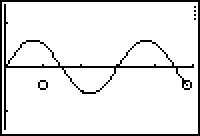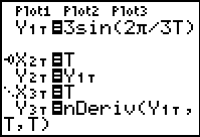Motion along a straight line was illustrated in Lesson 15.1. This lesson will explore harmonic motion, that is, motion that oscillates.
Simple harmonic motion is motion that can be modeled by either of the following functions, where t represents time and a, b, c, and d are constants:
The Motion of a Particle
Suppose that a particle moves along the vertical line x = 1 according to the equation below, where y represents the height of the particle above the ground and t is time in seconds.
Modeling the Particle's Motion
The motion of the particle from t = 0 to t = 5 seconds can be modeled using parametric equations.
- Set X1T = 1. This represents the vertical line on which the particle moves.
-
Set Y1T = 3sin(2*
 *T/3). This represents the motion of the particle along its path.
*T/3). This represents the motion of the particle along its path.
-
Set the Graph style to Animate by selecting the
 icon left of X1T.
icon left of X1T.

- Display the graph in a [0, 5, 0.1] x [0, 5, 1] x [-7, 7, 1] window. We will need more room on the graph screen later.
You should see the particle rise and fall along the vertical line x = 1.

-
Display the Window settings by pressing
 ,
,
- Change the value of Tstep to 0.05.
- Display the graph again.
15.2.1 What is the effect of this change on the graph? Click here for the answer.
Another Model
Add the following pair of equations to the Y= editor to produce another model for the particle motion.
- Set X2T = T.
- Set Y2T = Y1T.
-
Select "Path" (
 ) for the Graph style for this pair of equations.
) for the Graph style for this pair of equations.

- Make sure the Graph order in the MODE screen is still Simultaneous (Simul).
-
Display the graphs.
Only the new pair of equations appears to be graphed because no settings were changed for the first pair. - Use the ClrDraw feature in the Draw menu to regraph both pairs of equations.

15.2.2 Use the Trace feature on the second graph to determine when the particle is moving upward during the first five seconds. Click here for the answer.
15.2.3 When is the particle moving downward during the first five seconds? Click here for the answer.
15.2.4 When is the particle momentarily at rest (velocity is zero) during the first five seconds? Click here for the answer.
Graphing the Derivative
Add the following equations to the Y= editor to see the derivative (instantaneous velocity) of the particle.
- Set X3T = T.
- Set Y3T = nDeriv(Y1T,T,T).
- Set the Graph style of the derivative to "Dot."

- Display the graphs.

15.2.5 Use Trace on the velocity curve to find the first time the particle is momentarily at rest. Click here for the answer.
15.2.6 How does the derivative indicate when the particle is moving upward or downward? Click here for the answer.